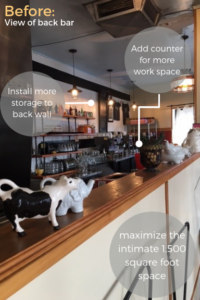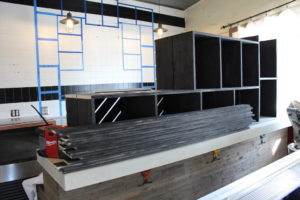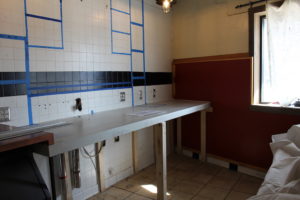As Seen In Good Life Detroit & Corktown Business Association
A restaurant is more than just a place to eat. It’s a place to connect, reflect on the day and unwind in good company. Corktown is one of our favorite corners of Detroit, so when the owner of Brooklyn Street Local agreed to us reinvigorating her space, we couldn’t contain our excitement. Brooklyn Street Local is an immensely popular and acclaimed urban-farm-to-table restaurant, a story we were drawn to. While visiting the restaurant we noticed the design of their space didn’t rightfully reflect the heart of their business, and we wanted to help. We approached the owner, Deveri Gifford, about doing an interior design case study on the restaurant for our market research to show how the power of strategic design can influence a small business and got the ok to hit the ground running.
The previous Brooklyn Street Local space wasn’t functioning properly to build the kind of atmosphere Deveri was looking for. Design concerns impacted both patrons and employees. To name a few, servers were causing traffic jams on their way to and from the kitchen, there was clutter piling up behind the bar, patrons had an unpleasant view of the kitchen, and the front door was drafty, causing crowded seating in the back of the restaurant. With all these issues converging, the success of the restaurant was truly being held back, and we had so many ideas to change that.
Although we were eager to get started, we needed to more deeply understand the business first. Our first step is always listening. In our exploratory meetings we discovered that:
- Brooklyn Street Local has a beautiful partnership with local urban farms, that wasn’t being conveyed to patrons. It’s at the heart of what they do, and telling that story was important to Deveri. In order to do that, brand messages needed to be more front and center.
- Employees craved a better workstation with more counterspace, and a better workflow to cut traffic between coworkers trying to access the kitchen or the back bar. It was clear functionality of the back bar needed major improvements, including clearing the counterspace clutter by adding more storage. This would have the added bonus of being nicer to look at, along with more functional.
- Patrons needed a better table layout in order to feel like the space was cozy and comfortable. One table by the door was often blasted with cold winter air, and no one wanted to sit there. With such little room it’s important all tables are utilized, and patrons are comfortable, so maximizing the intimate 1,500 square foot space was a necessity.
Here is a snapshot of our plan:
 The more we heard Deveri’s challenges, the more it became clear that the back bar was a key area to get right. We added counter space to the side wall and installed more shelving to improve the employee workstation.
The more we heard Deveri’s challenges, the more it became clear that the back bar was a key area to get right. We added counter space to the side wall and installed more shelving to improve the employee workstation.
 Before we got started, we used a 3D rendering to show Deveri what her new space would look like. We find this reduces client anxiety and often helps them make bolder choices that later bring much more satisfaction. Deveri could clearly see how we’d tie in her close relationship with local urban farms through a rustic, urban feel. She could also see how design can improve workflow for employees. By moving the bar down towards the window, it gave employees an entrance that was more accessible to both the back bar and the kitchen. This would reduce traffic among employees, which was a commonly voiced concern before.
Before we got started, we used a 3D rendering to show Deveri what her new space would look like. We find this reduces client anxiety and often helps them make bolder choices that later bring much more satisfaction. Deveri could clearly see how we’d tie in her close relationship with local urban farms through a rustic, urban feel. She could also see how design can improve workflow for employees. By moving the bar down towards the window, it gave employees an entrance that was more accessible to both the back bar and the kitchen. This would reduce traffic among employees, which was a commonly voiced concern before.
Now, our favorite part, watching the transformation happen before our eyes! First, we marked out exactly where we wanted the eye-catching shelving centerpiece.

 Seeing the materials come into the space started to pull everything together. The right mix of concrete, copper and distressed barn wood from local farms was the perfect recipe of materials to tell their story.
Seeing the materials come into the space started to pull everything together. The right mix of concrete, copper and distressed barn wood from local farms was the perfect recipe of materials to tell their story.
Now, after all the installation is complete, see the room transform before your very eyes!
The eye is now drawn towards the ceiling, making the limited space feel so much larger. What was once a space without enough storage, is now a haven for employees to find everything with ease.
The dining tables incorporated a mix of materials to tie back to the local urban farms that Brooklyn Street Local works closely with. Additionally, the display off the bar neatly presents local vendor products that the restaurants supports, while hiding the unsightly kitchen.
Beyond the bar is the addition of a half wall near the entrance. This not only provided privacy to customers but acted as a barrier to the bitter cold Michigan winter air that used to hit customers whenever the door was opened. Deveri Gifford, owner of Brooklyn Street Local said that since the renovation this table become the most coveted seat in the restaurant. That’s the power of human-centered design!
Deveri shares, “For small business owners, we’re trying to do everything, and to have someone else tell you, ‘Hey, here’s how we can make your life easier,’ that’s a huge relief.”
Just like that, the entire restaurant was elevated through better functionality, aesthetically pleasing design, on-brand materials, easier work flow and hiding the view of the kitchen. Yes, it looks so much better. But this isn’t just about making spaces beautiful. It’s about the success of a business. With a better organized work station, and a more pleasing atmosphere, both employees and patrons want to spend more time here. And we all know that time equals money!